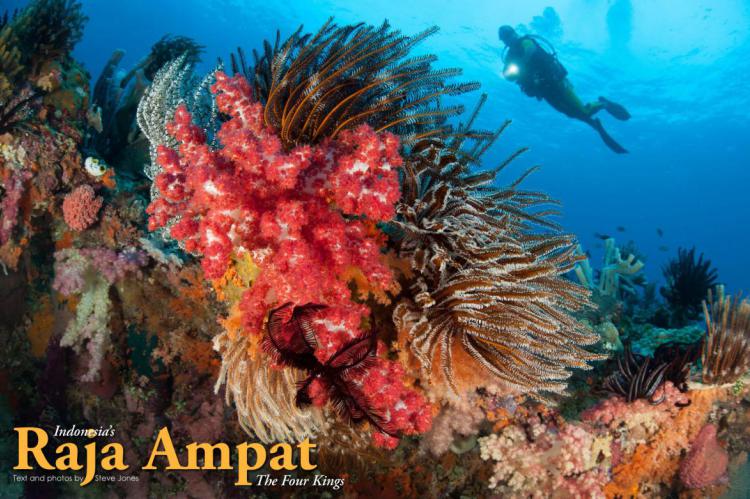Raja Ampat: The Four Kings
Swirling unicorn fish surround me and seem to have accepted me as one of their own. I can no longer see the surface nor anything else, save for a wall of fish. Only four minutes into the dive and it’s already evident that this site is living up to its reputation, literally boiling with fish. Moments like this remind me why I dive.
Tags & Taxonomy
At last, I reach the end of the reef, alone, and stare into the blue while I calm my breathing down. As the minutes pass, doubt creeps into my mind as to whether I’ve made the right decision. Everyone is enjoying the busy reef behind me and I am missing it all!
As I am about to give up, I glance a dark shadow before me in the blue, growing larger every second. I swim out from the reef and am greeted by the largest manta ray I have ever seen. Welcome to Blue Magic, a dive site that typifies the wonders to be found in Dampier Straight, one of the hotspots in Raja Ampat.
Diversity!
Over the past ten years or so, Raja Ampat has often been described as having some of the best diving to be found anywhere, but what makes this area so special? From my perspective, it can be summed up in one word: Diversity! It is prevalent here, not only in the habitats to be found, which in turn support the myriad of species, but also in the type of diving that can be experienced.
Those who enjoy stunning fish-packed seascapes that explode with colour will struggle to find a better location anywhere on the planet. Thrill seekers can enjoy high octane drift dives in those same currents that bring in manta rays. Those that enjoy the smaller things in life, the critters, will find themselves in the most biodiverse area of the world. Indeed, there are no less than 42 species of mantis shrimp in the area!
By land or by sea?
There are two ways to experience Raja Ampat. If you wish to concentrate on a specific area with a more laid back approach, then a resort will be a good choice. However, if you want to sample the full variety of seascapes here, then a liveaboard is the only way to sample what this huge 50,000 sq km area has to offer.
Around 40 vessels currently operate here, yet given the size of the Raja Ampat, you will generally encounter only a handful of other boats during your whole trip. Vessels also generally co-operate and avoid diving the same site at the same time as another boat, so your group will always have the reef to yourselves.
North or south?
Shorter liveaboard itineraries will generally follow either a northern route taking in the reefs of the islands around Waigeo, or head south to Misool. Itineraries approaching two weeks will allow the north and south to be sampled. These areas offer very different diving, so if you have the chance, make sure you visit both. Many cruise directors choose to round off the trips with dives in the current washed, spectacular reefs of the Dampier Strait.
Incidentally, current is an ever present feature of the dives in the region and of course, this is what makes the reefs so healthy. The common saying here is “no current, no life”. However, with good timing and the right choice of site, you’ll be able to see the reefs when they are at their best—that is when there is a mild current, enough to concentrate all the fish upstream, but not so strong that you are swept away from the “sweet spot”—the point where the current splits around the reef and where the most dense fish life will be found.
The northern areas
Northern itineraries will often head towards the spectacular limestone lagoon of Wayag—without doubt the most photographed topside location in Raja Ampat. A 30-minute hike up the steep limestone cliffs will allow a spectacular view of this stunning lagoon and provide great photographic opportunities.
Wayag and the surrounding islands are part of the Kawe Marine Protected Area (MPA) and the local village clans that steward these reefs have adopted a traditional approach, known as “Sasi” where no-take zones are seasonally rotated, allowing marine life stocks to recover between harvests.
These traditional and effective stewardship techniques are ones that many western fisheries have been unable or unwilling to adopt. Furthermore, on the nearby island of Piai, a guarded turtle rookery is helping the local populations of green and hawksbill turtle to recover—all good indicators that conservation efforts in Raja Ampat are able to turn words into actions.
One of the most stunning dives in this northern region is Magic Rock. Head to the north west side and you will find a large archway that leads into a hollowed out (...)
Download the full article ⬇︎

Originally published
X-Ray Mag #55
Indonesia's Raja Ampat; D-Day wrecks of Normandy; Costa Brava's underwater wine; Egypt's Red Sea wrecks; Turkey's Uluburun; Dr Mark Erdman profile; Tech: Bailout gas; Stretching for divers; Fluoro diving and photography; Lauren Kussro portfolio; Plus news and discoveries, equipment and training news, books and media, underwater photo and video equipment, turtle news, shark tales, whale tales and much more...






























